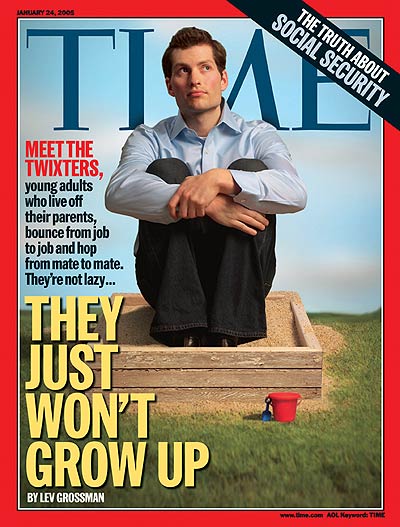 I can’t believe we’re going through this again.
I can’t believe we’re going through this again.
In January 2005, Time magazine featured on its cover a photo of a young man in a shirt and dress slacks sitting in a sandbox. The headline: “They Just Won’t Grow Up.” The article featured the research of one Jeffrey Jensen Arnett,PhD, a developmental psychologist who coined the term “emerging adulthood” to explain these puzzling, infantilized adults.
The cover story of the New York Times Magazine this weekend, already situated snugly at the top of the Most-Emailed List, is a near-exact repeat of this story from 5 years ago, this time asking “What is it About Twenty-Somethings?” Again Arnett is the resident featured expert. The Times’ only innovation, besides the slightly higher quality of the writing and the greater length, is tarting up the article with lots of sexy pictures of 20somethings (“I’m lying on my bed, all angsty! Look down my shirt!”) so readers can lust after them while simultaneously shaking their heads.

While they try on various social science hypotheses to explain this transition the overall tone of both articles is condescending, puzzled, frustrated, mocking. Both take the point of view of the print magazines’ aging readership: your mom, who wants you to get a job and an apartment and get married and give her grandchildren.
As I argued at great length in my book Generation Debt in 2006, and in dozens of articles for the Village Voice, Yahoo!, the New York Times, and the Washington Post dating back to 2004, the overwhelming reasons for this so-called “delayed transition” are economic. College costs 1000% more money than it did 30 years ago, yet it’s required for most living-wage jobs. Young people work longer hours while they’re in school, so it takes them longer to finish. Rent is higher too, and the youth unemployment rate is the highest for any age group. Young people have unprecedented amounts of student loan and credit card debt that persist into their 30s. Getting married, let alone starting a family, is difficult, even inadvisable, when you’re not financially stable.
Even when we as a nation try to remedy Generation Debt’s problems, we do so in a way that extends financial dependency. For example, the recent health care bill included a provision that young adults must be included on their parents’ health care policies until the age of 26. Why not mandate instead that the part-time service employers that overwhelmingly rely on young workers provide access to health care coverage?
There is no mysterious collective 20something malaise. The poor position of our nation’s future workforce is the outgrowth of decades of economic policy–the growth of consumer and national debt and the deterioration of the American job market, the protection of old-people programs like Social Security and Medicare and the faltering of opportunity-creating programs like education and health care for all. Maybe the Times should be talking to its own Paul Krugman, not a psychologist.
Or, if the Times editors wanted to emphasize the cultural and personal experience that emerges from this economic background, why not commission a young writer? Why is an article asking “What’s Up With Twentysomethings?” being written by a writer who is clearly at least in her 50s? I can think of half a dozen writers in their 20s who’d be great for the job. I’d have been happy to do it myself–I’ll be in my 20s for 3 more weeks.

